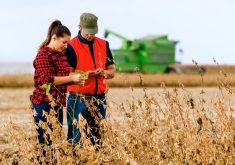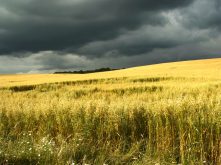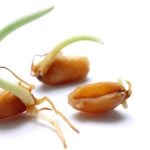Lately I have been curious about lettuce.
The plant has been traced back to Egypt some 6,000 years ago and is a member of the sunflower family. That may surprise you because we often think of sunflowers in terms of the flower and the oil. But lettuce was not grown for its leaves, it was grown for the seed which was made into oil.
Lettuce historically had a dual purpose — seed and milk. The milky stem on the mature plants was used as a narcotic (and sometimes as an aphrodisiac) and was a form of latex. Today much of the narcotic properties have been bred out.
Read Also

The great food summit adventure
Alberta Farmer columnist Lee Hart attended the Food Leadership Summit in Calgary, where about 400 ag industry players gathered for the new annual conference.
As history moved along, someone decided to start eating the leaves and thus began the development of the varieties we have today. Although lettuce is a good source of vitamin A and K, it is really only the darker-leafed varieties that have measurable food value.
In terms of food waste, the discard from growing lettuce is very high with the romaine variety being almost entirely trashed as only the heart of the plant is sold. The rest stays in the field. I have been privileged to be on lettuce farms, in greenhouses and in the processing plants where the leaves are washed and bagged or the heads put in a transparent clamshell for retail. The waste in the plant is also significant.
On average, a lettuce field will produce 26,000 heads per acre of which 75 per cent is marketable. As a shallow-rooted annual that is 97 per cent water, I wonder what the value is in taking highly productive, good draining land and growing a moderately nutritious plant. Use of water is 10 times higher in field lettuce than in vertical growing.
This is not an attack on lettuce farmers for they are responding to consumer demand. Though Canada is a top importer of lettuce it is also eighth in terms of lettuce exports (primarily to Asia). This export product is grown inside, often in a non-soil medium.
There are also 8,000 hectares of lettuce fields in the country. Those fields require significant inputs to prepare the seedbed, plant, fertilize, manage and harvest. As the land must have good drainage, there is a run-off environmental risk. And the labour component is huge in the entire production and processing. Transport of the retail or food-service-ready product is expensive as the load is light and has to be tightly temperature controlled.
Looking at the big picture, it is clear that a plant-based diet — particularly one built around high-input annuals such as lettuce — is costly in terms of land and water use, chemical and fertilizer use, labour and equipment, energy and environmental risk. Folks may not fully appreciate that the farmer responds to their demand and buying patterns and in doing so, that demand perpetuates land use for water-hungry annuals.
A society of privilege is a society of choice. But perhaps it is time to rethink our choices.
Every acre counts not only in food production for the day but in food production for the future. Given a choice, what would you like the food production of the future to look like?
Nutrient-dense plants that offer a broader spectrum of nutrition or food animals that contribute to regeneration of the soil would benefit both the farmer and the consumer. That does not mean that lettuce will not be grown, but there is a chance that it may very well be grown in the future for its oil, not leaves. Produced indoors in a non-soil medium and with less water is perhaps a better way to provide leaves and frees up highly productive land for other activities that can contribute to building microbes and retaining valuable water.
You can’t live on lettuce. Yet lettuce, tomato and onion are the consumer’s first choice — they are the most purchased raw foods in Canada. Tomato is a fruit brought to us by the Aztecs and traced back to 700 AD, while onions are recorded as a medicinal aid and then food as far back as the Bronze Age.
There is a lot of history behind the food we eat that transcends into consumer choices. However, the growing global population, the shortage of cooking oil, the pressure on land and the disruptions in the supply chain may change the salad plate to a nutrient-fuelled experience that includes not only fibre, vitamins and minerals but robust offerings of animal proteins.
While consumers are facing the task of making their food budget stretch, farmers are facing huge production and marketing challenges across the globe.
They need to be supported as they transition into new products and markets for fresh and value-added foods. There is a smorgasbord of both choice and opportunity. We cannot know what the future holds, but sometimes a peek at history influences what road will be travelled.
















